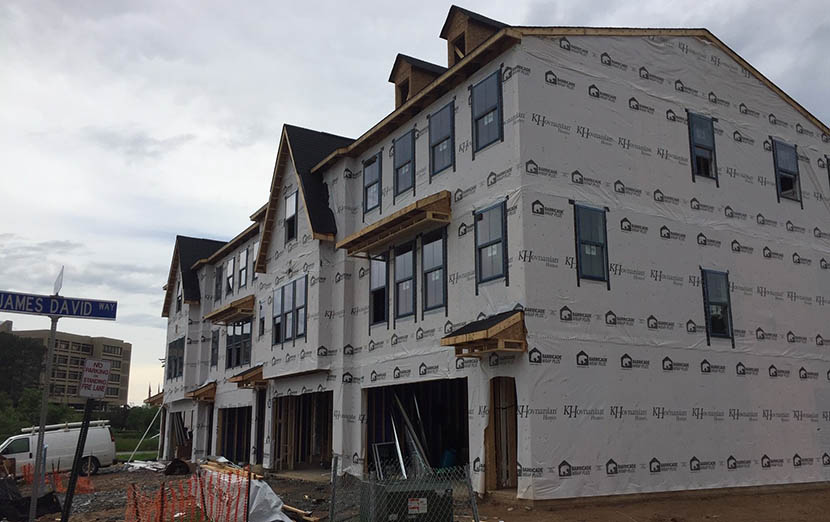
Homebuying Demand Higher Than Before Pandemic; New Home Share at 8-Year High

Amid some absolutely dreadful housing news lately, there are signs of resilience—and perhaps, the seeds of recovery.
While existing home sales took a hit last week, falling to nearly 10-year lows, Redfin, Seattle, reported for the seven days ended May 17, homebuying demand rose by nearly 17%, driven by near-record low mortgage rates. Redfin also reported newly built properties now represent one in five homes on the market, up one in six last year to its largest share since at least 2012.
“The spring market is about to kick off after a two and a half month delay,” Redfin said.
Redfin, which announced furloughs of nearly 1,000 employees in April, said it has brought back more than one-third of them to handle the rapid rise in home-buying demand.
Redfin said despite a steady dose of new cases of coronavirus and another 2.4 million Americans filing for initial unemployment benefits in the past week, homebuying demand seems to have been largely unaffected, thanks to near record-low mortgage rates that have continue to stimulate the market.
And where demand is picking up is changing as well, Redfin said. Search data from Redfin.com suggests that migration from expensive metropolitan hubs to smaller cities and towns has been happening for years, but it seems to be gaining steam since the coronavirus outbreak—and as millions of Americans working remotely have now realized that they could—permanently—work at home from anywhere in the U.S., interest is moving away from more expensive areas in or near urban centers.
“The pandemic has people re-evaluating their lifestyle and their goals,” said Tiffany Aquino, a Redfin agent in Virginia. “People who were considering a move two or three years down the line are pulling the trigger now. I have one client who’s planning to retire early, cash in on high home prices in Virginia and move to South Carolina. Another client is selling her home here to move to Florida full-time to take care of her elderly father. People are putting family priorities first.”
Redfin said buyers are increasingly using digital technology to see homes without having to be there in person. Over the past week, just over one in four new Redfin clients had their first home showing via video chat and video-chat tours led to 11% of the offers Redfin agents wrote in that same time. 3D scans are surging as well; nine percent of all new listings that launched the week of May 10 included a Matterport scan and views of Matterport scans on Redfin.com have more than doubled in the last month.
Redfin reported the number of homes for sale is down 23% for the seven days ending May 15, compared to the same period a year ago. But the absolute count of homes for sale inched up each of those days. Low inventory is constraining the number of home sales, but prices are rising
“Whether it’s increasing comfort or rising concerns about the future, more sellers put their homes on the market in the seven days ending May 15 than any seven day period since March 25,” Redfin said.
The report can be accessed at https://www.redfin.com/blog/home-buying-demand-reaches-new-peak-demand-unleashed/.
In a separate report, Redfin said the number of newly built homes on the market fell just 10.5% year over year in April, the smallest decline in 2020 to date. The supply of existing homes plunged 24% during the same period. With the supply of existing homes sinking, new properties now make up a bigger piece of the pie. Last month, one in five homes on the market was a newly built home. That’s up from one in six last year and represents the largest share since at least 2012.
Redfin lead economist Taylor Marr said inventory of existing homes has plummeted amid economic uncertainty and health concerns fueled by the coronavirus pandemic, with an increasing number of Americans choosing to delist their homes or not even put them up for sale in the first place. Meanwhile, the supply of new-construction homes has seen a relatively small drop, as builders and homeowners approach home selling differently.
“Builders are running a business and focused on the bottom line, so they need to clear their inventory as quickly as possible at any given time, especially during an economic downturn,” Marr said. “Homeowners, on the other hand, decide to move, list and sell when the time is right, for the right price, and sometimes even to the right buyer. For many homeowners, a pandemic is not the ideal time to move and have strangers come through their homes, so those who have the flexibility are putting off listing for now.”
Still, builders have been putting fewer houses on the market than they did last year as they’ve had to halt projects amid restrictions on construction activity and permitting delays. New listings of newly constructed homes fell 12% month over month in April, though that pales in comparison to the 36.3% slide in new listings of existing homes.
When broken down by new-home type, condos fell the most, with new listings sliding 29.5% month over month in April. That compares with a 9.8% drop in new listings of single-family homes.
Sales of both new and existing homes fell by 20% year over year in April, as buyers were less likely to purchase any kind of home—be it new or old—than they were at the same time last year. The median sale price of new homes slipped 2.3% year over year in April to $359,000—the first monthly decline of 2020. Meanwhile, existing home prices were up 6.2% to $294,000.
The report can be accessed at https://www.redfin.com/blog/new-home-construction-april-2020.
